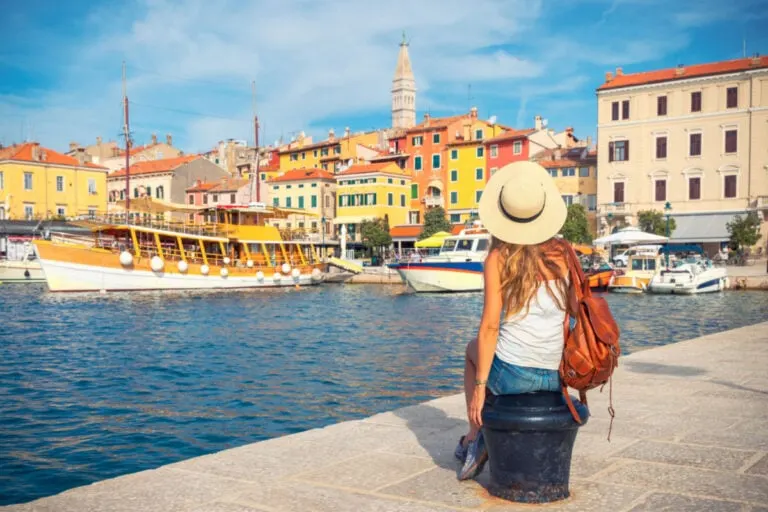If you’ve been dreaming of picturesque towns that look as if they’ve been plucked out of a fairytale book, Roman ruins with origins lost to the passing of time, and alfresco dinners and wine as the sun sets over azure waters, Italy is likely to be on your bucket list this year.
As great as it sounds, these idyllic summers do not come without concessions, be it the depletion of your savings or even surrendering your rights as a visitor.
Try finding a room in floating Venice for under $300 a night in August, or taking a selfie at this famous photo spot in Portofino.
Just to give you a heads up regarding the latter, maybe don’t if you don’t want to get fined.
Italy has had it with mass tourism, and it’s taking several controversial steps to clamp down on the phenomenon, it’s no wonder Americans no longer feel as welcome there as they might have once been––luckily, Il Belpaese is not the only answer to your dolce vita prayers:
How Does Istria Feel So Italian?

When you picture Istria, with its typical Italian architecture, Mediterranean cuisine, and even the Southern European complexion of locals, you might be mistakenly led to believe it is any other Italian region, and you wouldn’t be too far off:

You see, prior to World War II, Istria was in fact largely Italian, and it had been so for several centuries, first as part of the now-extinct Republic of Venice, and later as a integral part of the Italian Kingdom and its subsequent Republic.
It was only ceded to Croatia after the neighboring country lost the conflict, but that does not mean Istria itself lost its ‘Italianness’:
Picturesque Old Towns And Teal-Colored Seas

A historic fishing port located at the tip of a headland, hugged by waters of the clearest blue, Rovinj once served as an extension of Venice, minus the canals: the car-free tangle of cobbled lines is lined by skinny pastel buildings and, much like La Serenissima, speared by a medieval campanile.
That’s a running theme across Istria: a short 46-minute drive north, Poreč takes a page out of the same town-building book, sitting on a narrow peninsula, and boasting an unusually-high concentration of Byzantine landmarks for a small settlement of 16,696.
Let’s not forget Pula, or ‘Rome by the Sea‘: a seaside resort with a fascinating history spanning thousands of years, it is dominated by a perfectly-preserved Roman arena, which unlike the Colosseum, still has all its curvature intact.
Though it’s the beach-lined coast that typically gets all the most buzz, charming Motovun should not be bypassed, either: sitting on a prominent hill in central Istria, it is a postcard-perfect fortified village surrounded by lush-green scenery.
Underrated Coastal Paradise
Italy is as sought-after for its nature as it is for its cultural heritage, and as a former part of Italy, Istria is no exception:
The Dalmatian Coast may be far more popular among foreign visitors, as it hosts the busy tourism hotspots of Split and Dubrovnik, as well as an extensive list of Blue Flag beaches, but the Istrian coastline is not to be underestimated.
Just outside Roviny, Mulini Beach is a Croat summer paradise, with tiny, walkable pebbles and translucent waters––there’s also a beach bar on site, and renting an umbrella and two beds for the day will cost you only $65, or the equivalent in euro.
The family-friendly Fazana Beach, about 31 miles from Poreč, is a peaceful oasis straddling calm, shallow waters, while the sand-and-pebble Valalta and its marine reserve with winding footpaths leading to secretive coves is reserved for adventurous nudists.
A national park comprising high sea cliffs and moon-like stone surfaces perfect for catching a tan, Kamenjak is yet another natural wonder claimed by Istria, and it can be visited on a boat tour, dinner included for as cheap as $44 (you may even spot a jumping dolphin!).
Istria Is Cheaper Than Italy

While it is certainly not as cheap as up-and-coming Montenegro or Greece-on-a-budget Albania, spending a week relaxing at a beachside hotel and exploring its cultural highlights will most certainly not break the bank.
Based on estimates provided by the search engine Trip My Dream, a continental lunch in a local restaurant in Pula costs $16.35, while a seafood dinner with a vegetable salad is around $21.79.
Getting some take-out calzoni from bakeries in Rovinj, you’re unlikely to spend more than five bucks, and if you’re doing groceries to cut down on travel costs, it’s even more affordable: a kilo of seasonal fruit, freshly-picked, none of the chemicals you get in America, costs about $2.18.

Additionally, the average cost of museum tickets in Istrian cities is a negligible $3.27, with the exception of major points of interest like Pula Arena, where it’s still an acceptable $10.90 to visit, and day tours are usually priced at $65.38.
As for accommodation, the average price of a 3-night stay in Istria is $227, according to Budget Your Trip, with privately-managed Apartments Anja in Rovinj listed for $98 and double rooms at Pula’s mid-range Hotel Veli Jože running you up only $69 a night.
There’s definitely a range here, but unless you’re actively looking to splurge, budgeting $871 – $900 for a one-week trip to Istria is realistic enough.
Credit: Source link




